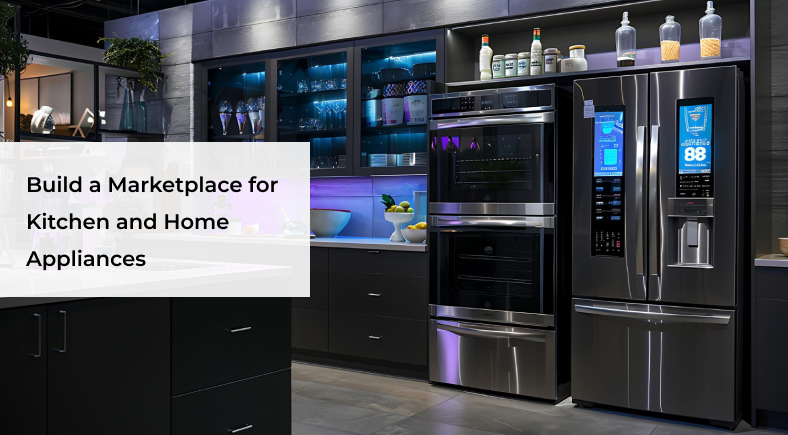Published date 27th Nov 2025
In an era defined by convenience and connectivity, the way we shop for household essentials has fundamentally changed. The once traditional market for kitchen and home appliances, including refrigerators, washing machines, blenders, smart ovens, and more, has now rapidly migrated online. Consumers now demand not just competitive pricing but also a wide variety, rich product information, and a seamless shopping experience.
This dramatic shift has opened up a unique and highly lucrative opportunity: the Kitchen and Home Appliance Marketplace. By moving beyond the limitations of a single-brand or single-retailer eCommerce store, a multi-vendor marketplace offers scalability, choice, and convenience that today’s consumers demand.
If you are an entrepreneur, a traditional retailer looking to go online, or a business owner seeking the next high-growth niche, now is the perfect time to build a marketplace for kitchen and home appliances. This comprehensive blog will walk you through everything you need to know, from understanding the market dynamics and essential features to selecting the right development approach to ensure your long-term success.
Table of Contents
- What is a Kitchen and Home Appliance Marketplace?
- Why Build a Kitchen and Home Appliance Marketplace in 2026
- Building a Home Appliance Marketplace: Best Types to Consider
- Must-Have Features For Your Kitchen and Home Appliance Marketplace
- Understanding Development Approaches: Custom vs Ready-Made Software
- Which Marketplace Development Approach is Best?
- Yo!Kart- Best eCommerce Marketplace Solution to Build Kitchen and Home Appliance Marketplace
- Conclusion
- FAQs
What is a Kitchen and Home Appliance Marketplace?
The Kitchen and Home Appliance Marketplace is a specialized type of multi-vendor eCommerce platform. Unlike a standard online store, which sells products from a single company’s inventory, a marketplace acts as an intermediary. It allows multiple independent sellers, including major manufacturers, authorized distributors, small local retailers, and specialized gadget makers, to register, list, and sell their products to a unified customer base, creating a diverse and competitive environment between sellers.
Key Characteristics:
- Multi-Vendor Model: Multiple sellers can list their products, including refrigerators, washing machines, ovens, blenders, etc., on the platform, offering customers a wide variety of brands, models, and price points.
- Centralized Platform: The marketplace owner (the admin) manages the overall platform, marketing, payments (commissions), and customer experience, while sellers manage their own inventory, shipping, and product listings.
- Specialized Niche: By focusing solely on kitchen and home appliances, it caters to specific customer needs, offering better filtering, comparison tools, and more. It includes products ranging from white goods (refrigerators, washing machines) to small kitchen appliances (mixers, coffee makers) and smart home technology (IoT devices, smart security).
In essence, a Kitchen and Home Appliance Marketplace simplifies the appliance shopping process by providing a one-stop shop for a broad range of products and services, while allowing sellers to reach a wider audience.
Why Build a Kitchen and Home Appliance Marketplace in 2026?
Launching a new venture begins with identifying a clear market opportunity. With consumer expectations changing and new technologies reshaping the industry, the home appliance sector presents a lucrative opportunity for a kitchen and home appliance marketplace.
1. Market Growth and Digital Acceleration
The global home and kitchen appliances market is experiencing significant growth, driven by increasing disposable incomes, urbanization, and a high replacement rate for older models. Moreover, a report by Grand View Research states that the global kitchen appliances market size will reach $356.47 billion by 2030, growing at a CAGR of 5.9% from 2023 to 2030. Crucially, a massive portion of this growth is happening online. Consumers are now comfortable buying large, high-value items like refrigerators and washing machines over the internet, provided the platform offers transparency and trust.
2. High Average Order Value (AOV)
Home and kitchen appliances, especially large ones, carry a naturally high price tag. This translates to a significantly higher Average Order Value (AOV) compared to general retail. For a marketplace owner, this means higher commission revenues per transaction, making the business model highly profitable even with lower transaction volumes than, say, a fashion marketplace.
3. The Shift to ‘Smart’ and Specialization
The rise of the ‘Smart Home is a game-changer. Consumers are actively seeking integrated (Internet of Things) IoT-enabled appliances. Hence, a specialized marketplace can become the central hub for discovering and comparing these complex, feature-rich products from different brands, which is often difficult on general eCommerce sites. Thus, a niche focus marketplace allows you to capture the high-value segment of tech-savvy buyers.
4. Overcoming Brick-and-Mortar Limitations
Traditional appliance retail is limited by physical store space, making it impossible to showcase every model from every brand. Comparatively, an online marketplace offers infinite shelf space, allowing vendors to list their entire catalogue, including obscure models and new product lines. Thus offering an unparalleled selection to the customer.
Start Your Home Appliance Marketplace to Capitalize on Market Growth!
Building a Home Appliance Marketplace: Best Types to Consider
The multi-vendor model lets you build a marketplace that really stands out. Moreover, its flexibility makes it easy to tailor your platform to cater to different customer needs, whether that’s major appliances, smart home gadgets, or niche kitchen tools. This approach helps you focus on high-demand segments and position your business for strong growth in the home appliance market. Additionally, you can target the appliance sector with several specific marketplace types, including:
| Marketplace Type | Description | Target Audience | Revenue Model |
| B2C (Business-to-Consumer) | The most common type. Multiple brands/retailers sell new appliances directly to end -consumers. | Households, individuals, and new homeowners. | Commissions on sales, featured listings, and ads. |
| B2B (Business-to-Business) | Connects appliance manufacturers/wholesalers with businesses like hotels, property developers, commercial kitchens, or service providers. | Real estate developers, construction companies, bulk buyers. | Commissions, subscription tiers, volume discounts. |
| Rental/Leasing | A platform for renting or leasing appliances (e.g., furniture rental for temporary housing, student accommodation, or commercial events). | Students, short-term renters, and event organizers. | Monthly subscription fees, commissions on contracts. |
| Refurbished/Second-hand | A specialized platform for certified pre-owned, refurbished, or open-box appliances. Focus on inspection and warranty is key to trust. | Budget-conscious consumers, eco-conscious buyers. | Commissions, inspection/certification fees. |
| Service Marketplace | Connects buyers with certified technicians for installation, repair, and maintenance services for appliances. | Homeowners needing post-purchase support. | Lead generation fees, service commissions. |
Expert Recommendation: For a first-time launch, the B2C model offers the broadest market reach and the most straightforward path to profitability. You can integrate service booking or refurbished sales as niche add-ons later.
Must-Have Features For Your Kitchen and Home Appliance Marketplace
A successful marketplace requires a robust feature set that caters to the specific needs of high-value, research-intensive appliance shopping. Therefore, your platform must include three distinct interfaces: Admin Panel, Seller Panel, and Buyer Interface. Let’s have a look at them:
1. Essential Buyer Interface Features
- Advanced Search & Filtering: Beyond basic filters, customers need to filter by highly technical specifications like:
- Energy Star Rating / Energy Efficiency
- Capacity (e.g., refrigerator volume, washing machine load)
- Installation Type (e.g., built-in, freestanding)
- Smart Features (e.g., Wi-Fi connectivity, voice assistant compatibility)
- Brand, Colour, Price Range.
- Detailed Product Comparisons: Your platform must allows buyers to select 2-4 products and view a side-by-side comparison of all key specs.
- High-Fidelity Media: Support for 360-degree product views, high-resolution zoomable images, and product demonstration videos.
- Geo-Location & Delivery Slot Booking: Since appliances require specialized shipping, the platform must accurately calculate shipping costs and estimated delivery times based on the buyer’s location. Additionally, it should offer flexible delivery/installation slot options at checkout.
- Reviews and Ratings (Parameter-Based): Allow buyers to rate not just the product, but also the seller’s service (packaging, delivery speed, installation).
2. Powerful Seller Panel Features
- Intuitive Product Management: An easy-to-use dashboard for bulk product uploads, managing inventory, updating prices, and running promotions specific to their shop.
- Order and Shipping Management: Tools for sellers to process orders, generate shipping labels (often integrated with third-party logistics/LTL (Less Than Truckloads) carriers), and update order status for real-time customer tracking.
- Sales and Analytics Dashboard: Real-time reports on sales performance, top-selling products, commission statements, and customer feedback.
- Flexible Commission Management: The platform must allow the admin to set different commission rates for different product categories or individual sellers.
3. Comprehensive Admin Panel Features
- Multi-Vendor Management: A central system for approving new sellers, managing their accounts, reviewing their performance, and setting commission structures.
- Tax Management: An in-built or integrated module to handle complex taxes, such as VAT, GST, etc., based on the buyer/seller locations, which is critical for high-ticket items.
- Dispute and Return Management: A streamlined workflow for handling customer returns, refunds, and resolving disputes between buyers and sellers.
- CMS (Content Management System): Tools to easily update website content, run promotional banners, and manage SEO for category pages to target keywords like “build kitchen appliance marketplace” and “create home appliance marketplace.”
- Payment Gateway Integration: Secure integration with multiple payment providers, including Stripe, PayPal, etc., to facilitate split payments, allowing the platform to take its commission before transferring the rest to the seller.
Create a Feature-Rich Marketplace for Kitchen and Home Appliances
Understanding Development Approaches: Custom vs Ready-Made Software
The path you choose for development determines your time-to-market, initial investment, and long-term flexibility. However, there are two primary approaches for building a multi-vendor marketplace. Let’s explore both of them:
Custom Development
Custom development involves building the entire platform from the ground up using a dedicated team of software engineers, designers, and project managers. You start with a basic framework and carefully code every feature, workflow, and integration to meet your exact specifications.
Pros:
- Absolute Control: Complete ownership and control over the source code, logic, and future direction.
- Perfect Fit: The final product is a perfect match for a highly unique or complex business model.
- Seamless Integration: Can be designed to integrate perfectly with existing proprietary systems (e.g., legacy inventory software).
Cons:
- Time-Consuming: The process typically takes 6 to 12 months or even more, depending on the complexity, delaying your entry into the market.
- High Initial Cost: Requires a significant upfront investment in design, development, and quality assurance.
- Ongoing Overhead: You are responsible for all maintenance, security patches, bug fixes, and continuous feature development.
Ready-made Solution
A ready-made ecommerce solution is a pre-built, robust platform designed specifically for the multi-vendor marketplace model (e.g., Yo!Kart eCommerce Marketplace Software). These solutions come with the core features (Admin, Seller, Buyer panels, payment gateways, etc.) already developed, tested, and ready to deploy.
Pros:
- Rapid Launch: You can go live in a matter of weeks, allowing you to validate your business idea quickly.
- Cost-Effective: The upfront cost is dramatically lower than custom development, as the cost is distributed across multiple users.
- Proven Reliability: The software has been tested in real-world scenarios across various industries.
- Dedicated Support: The vendor is responsible for continuous development, updates, and providing technical support.
Cons:
- Minimum Server Requirements: You need to meet the minimum server requirements to run the marketplace efficiently.
Which Marketplace Development Approach is Best?
For a high-stakes, specialized market like home appliances, a clear choice emerges based on resource constraints and urgency. Have a look at the comparison of both approaches:
| Criteria | Custom Development | Ready-made Solution |
| Time to Market | 6-12 months | 1-4 weeks |
| Development Cost | Very High | Budget-Friendly |
| Customization | Fully Customizable | Customizable to some extent |
| Technical Expertise | Required | Minimal Required |
| Mobile Apps | Extra Cost and Time | Included (iOS & Android) |
| Support | Self-managed | Technical support up to 12 months |
| Scalability | High | High (Built on modern, robust architecture) |
Recommendation: For 9 out of 10 entrepreneurs and businesses looking to launch a home appliance marketplace, the Ready-made solution provides the fastest, most cost-effective, and lowest-risk path to market, offering high scalability and customization that rivals custom builds.
Yo!Kart- Best eCommerce Marketplace Solution to Build Kitchen and Home Appliance Marketplace
When selecting a ready-made solution, it is essential to choose a solution that is robust, scalable, and specifically designed for a multi-vendor marketplace. One such solution is Yo!Kart, a purpose-built, licensed eCommerce marketplace software that has emerged as a leader for niche marketplaces, offering a comprehensive suite of tools perfectly suited for the home appliance sector.
Furthermore, its scalable architecture allows marketplaces to grow seamlessly, accommodating more vendors, expanding product categories, and handling increasing traffic without performance issues. This allows marketplace owners to focus on strategic priorities, such as onboarding reputable appliance brands, marketing to their target audience, and optimizing sales.
Why Yo!Kart is Ideal for the Appliance Niche:
1. Multi-Cart/Multi-Vendor Checkout: A crucial feature where a buyer can purchase products from multiple sellers in a single transaction, streamlining the high-AOV checkout process.
2. Product Catalogue System: This allows the admin to maintain quality control over product data. In the appliance sector, this ensures all sellers use standardized, accurate specifications (e.g., standardizing the measurement for ‘capacity’ across all refrigerator listings).
3. Dedicated Mobile Apps (iOS & Android): These are essential for modern shopping, providing a seamless mobile experience for buyers and a robust management tool for sellers.
4. Advanced Commission Management: The platform provides fine-grained control for the admin to set percentage-based, flat-rate, or category-specific commissions, maximizing revenue channels.
5. Multi-Language and Multi-Currency Support: Essential for scaling into new regions or serving diverse communities, allowing you to target a broader audience.
6. PWA Compliant: The platform supports Progressive Web Apps (PWAs), ensuring a fast, app-like experience on all devices, which is critical for reducing abandonment during the often long research phase of appliance shopping.
7. In-Built Marketing & SEO Tools: It offers features like banner management, discount coupon creation, and SEO-friendly URLs, helping you target competitive keywords and drive organic traffic.
8. Source Code Ownership: Unlike SaaS models, Yo!Kart is a one-time license purchase that grants you full source code ownership. This provides the core advantage of custom development, unlimited customization, without the initial time and cost burden.
Hence, by leveraging a solution like Yo!Kart, you are immediately equipped with an enterprise-grade platform, allowing you to focus your resources on acquiring quality vendors (major appliance brands/distributors) and marketing to your target audience, rather than on complex coding and maintenance.
Unlock Yo!Kart’s Full Potential
Conclusion
The market for kitchen and home appliances is entering a digital transformation, and the multi-vendor marketplace model is an ideal choice for that change. Moreover, by aggregating fragmented inventory, offering unparalleled selection, and providing advanced, niche-specific features, you can quickly build a position of authority and trust.
However, the key to a successful launch in 2026 lies in choosing the right foundational technology. While custom development offers ultimate flexibility, the cost, time, and resource demands are often prohibitive for a new venture. A powerful, customizable, readymade solution, such as Yo!Kart, significantly reduce the risks to launch, providing a proven, scalable platform that allows you to start generating revenue in weeks, not months or years. Additionally, it allows you to focus on building a strong community of vendors and delivering a flawless customer experience.
FAQs
Q 1. How much time does it take to build a marketplace with Yo!Kart?
Ans. Building a marketplace with Yo!Kart typically takes between 1 to 4 weeks. This timeline covers the entire setup process, including branding, configuring core features, and onboarding initial sellers and products. Further, the platform is designed for rapid deployment, allowing you to go live much faster compared to custom development, which can take 6 to 12 months.
Q 2. Do I need technical knowledge to set up my marketplace with Yo!Kart?
Ans. No, you don’t need technical knowledge to set up your marketplace with Yo!Kart. The platform is designed to be user-friendly, which allows non-technical users to manage products, sellers, commissions, and content. While you may need minor technical support for hosting or advanced integrations, the vendor typically offers excellent setup assistance, minimizing the need for in-house technical expertise.
Q 3. Does Yo!Kart offer post-launch support?
Ans. Yo!Kart offers dedicated post-launch support for the initial launch period. This includes technical assistance, bug fixes, and help with performance issues. Additionally, you’ll have access to ongoing updates and feature improvements. In contrast, with custom development, all post-launch maintenance and bug fixing fall entirely on your own team or hired agency, incurring continuous cost.
Q 4. How much cost difference is there between custom development and launching a home appliance marketplace with a ready-made solution?
Ans. The cost difference between custom development and a ready-made solution (like Yo!Kart) is significant:
- Custom Development: Building a fully custom marketplace from scratch typically costs between $50,000 and $200,000+ (or more), with a development timeline of 6-12 months. Additionally, you also need to account for ongoing maintenance costs, bug fixes, and additional feature development.
- Ready-Made Solution (Yo!Kart): A ready-made solution like Yo!Kart comes with a one-time licensing fee, which is generally far more affordable than custom development. Furthermore, the pricing packages offered by Yo!Kart starts at just $499, and this solution allows you to go live in 1 to 4 weeks.




